-
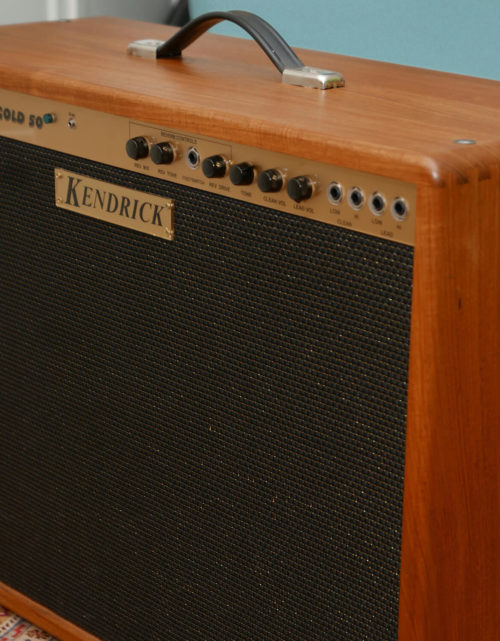 This was one of the best amps ever made by the legendary Gerald Weber. All-tube circuitry, designed and made in the USA, by Weber. It not only has power to spare (50 watts), but its unique circuitry has two channels, clean and lead, with different preamp circuit. These channels can be blended through patching the second input of one channel into the first input of the other, for purposes of blending the two channels together and further tone shaping with the interactive tone circuit. The bottom line: Tons of power if you need it, but the ability to get all the creamy, lush lead tones with the lead channel and/or blending. You just have to hear it. Original, handmade hardwood cabinet. 2 x 12: one 12 inch Kendrick brown frame and one 12 inch Kendrick black frame speaker. Kendrick's double spring reverb with three controls. Great condition. Recently serviced by one of the best amp techs in Texas. Price: $1495. No shipping. Local pickup only in Austin.
This was one of the best amps ever made by the legendary Gerald Weber. All-tube circuitry, designed and made in the USA, by Weber. It not only has power to spare (50 watts), but its unique circuitry has two channels, clean and lead, with different preamp circuit. These channels can be blended through patching the second input of one channel into the first input of the other, for purposes of blending the two channels together and further tone shaping with the interactive tone circuit. The bottom line: Tons of power if you need it, but the ability to get all the creamy, lush lead tones with the lead channel and/or blending. You just have to hear it. Original, handmade hardwood cabinet. 2 x 12: one 12 inch Kendrick brown frame and one 12 inch Kendrick black frame speaker. Kendrick's double spring reverb with three controls. Great condition. Recently serviced by one of the best amp techs in Texas. Price: $1495. No shipping. Local pickup only in Austin. -
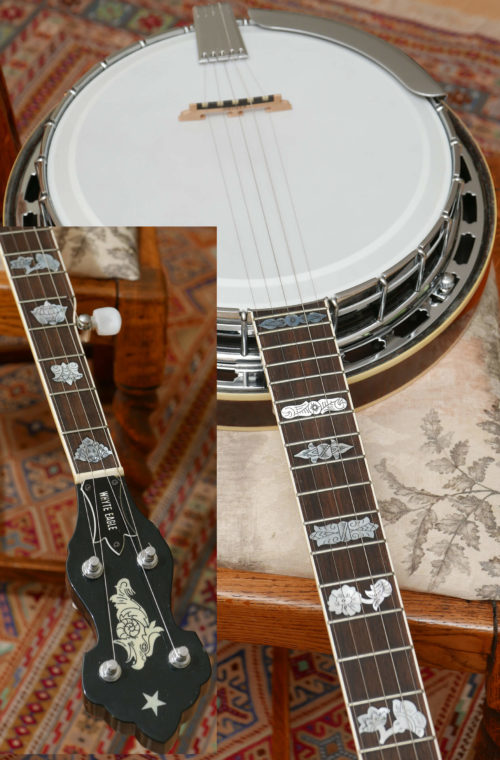 Early 1970s, but in remarkably original condition. And this instrument is from the first, early production– so it has the maple 3-ply rim. This should not be compared to later production Whyte Eagles– this is a very rare early one with unique features, and great tone. This banjo design is based on: • neck/head/inlays: based on the high end Fairbanks Whyte Ladye of the early 20th century– one of the most beautiful designs in banjo history • the pot assembly is modeled closely on the Gibson TB3, archtop of the 1930's. In fact it's a remarkable recreation of that design (and sound) – a more faithful recreation that many Gibson post-war versions. Bluegrass banjo players seek out the 70’s Alvarez Whyte Eagles, known for their tone and craftsmanship. It was a pretty short window of only about five years, when these banjos were made with this kind of craftsmanship. They blow away most any banjo made and marketed (from any country) in the 60s, 70s and 80s– and they show no logos on headstock– just beautiful mother of pearl. It’s the No. 4310 “Whyte Eagle”. Based on late 1920’s Vega Griffin (Tubaphone #9) style inlays, with engraved, carved heel. Sunburst finish maple banjo, Gibson-style 2 piece flange, full height 20 hole archtop tone ring, dual coordinator rods, flamed maple resonator, maple neck, chrome finish. Neck is butterfly with ebony strip on back of neck, down the center. It’s extremely rare to find a Whyte Eagle from this very early period (serial number 1672), when they first came out and the company bent over backwards to produce an instrument with zero compromise, from the inlays to the maple rim. The early features that are not on the later 70's Whyte Eagles, are– in addition to the 3-ply maple rim (not the 10-ply rim of almost all other Whyte Eagles)– the smaller star on the front of headstock (later models had a larger star), no “Alvarez” logo just the eagle inlay, and a darker sunburst on the resonator and also on the back of the neck. Flamed maple resonator (sunburst back, with a touch of milkiness to the original finish) Maple butterfly neck Hand-carved heel Mother of pearl inlays Original tuners Grover bridge 1 3/16 nut Scale: 26 ¼ inches 20 hole archtop tone ring 11 inch head ... no longer available ...
Early 1970s, but in remarkably original condition. And this instrument is from the first, early production– so it has the maple 3-ply rim. This should not be compared to later production Whyte Eagles– this is a very rare early one with unique features, and great tone. This banjo design is based on: • neck/head/inlays: based on the high end Fairbanks Whyte Ladye of the early 20th century– one of the most beautiful designs in banjo history • the pot assembly is modeled closely on the Gibson TB3, archtop of the 1930's. In fact it's a remarkable recreation of that design (and sound) – a more faithful recreation that many Gibson post-war versions. Bluegrass banjo players seek out the 70’s Alvarez Whyte Eagles, known for their tone and craftsmanship. It was a pretty short window of only about five years, when these banjos were made with this kind of craftsmanship. They blow away most any banjo made and marketed (from any country) in the 60s, 70s and 80s– and they show no logos on headstock– just beautiful mother of pearl. It’s the No. 4310 “Whyte Eagle”. Based on late 1920’s Vega Griffin (Tubaphone #9) style inlays, with engraved, carved heel. Sunburst finish maple banjo, Gibson-style 2 piece flange, full height 20 hole archtop tone ring, dual coordinator rods, flamed maple resonator, maple neck, chrome finish. Neck is butterfly with ebony strip on back of neck, down the center. It’s extremely rare to find a Whyte Eagle from this very early period (serial number 1672), when they first came out and the company bent over backwards to produce an instrument with zero compromise, from the inlays to the maple rim. The early features that are not on the later 70's Whyte Eagles, are– in addition to the 3-ply maple rim (not the 10-ply rim of almost all other Whyte Eagles)– the smaller star on the front of headstock (later models had a larger star), no “Alvarez” logo just the eagle inlay, and a darker sunburst on the resonator and also on the back of the neck. Flamed maple resonator (sunburst back, with a touch of milkiness to the original finish) Maple butterfly neck Hand-carved heel Mother of pearl inlays Original tuners Grover bridge 1 3/16 nut Scale: 26 ¼ inches 20 hole archtop tone ring 11 inch head ... no longer available ... -
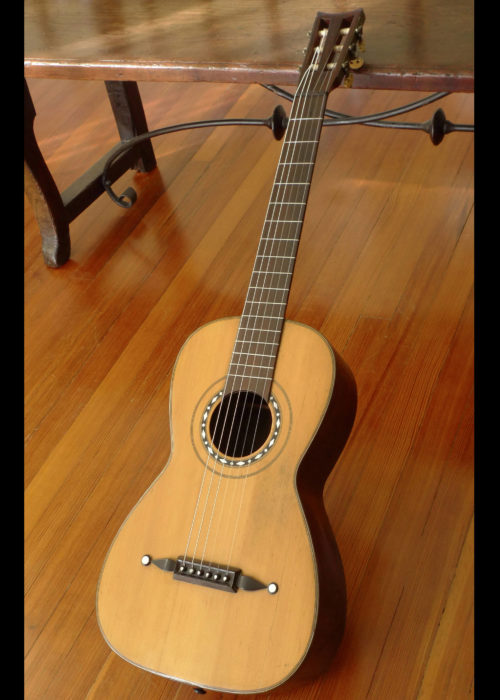 More rare than a Panormo guitar, this original, wonderfully preserved and sonorous guitar is from the London-based J. Guiot, circa 1846– and it’s a cousin if not a sibling of a Panormo, in style, appointments, and provenance. The headstock and neck volute of this instrument, as well as the bridge, exactly match that of two known Guiot guitars of the period (see links below). It’s possible that this guitar was made in the workshop of Panormo by Guiot while he worked there, and it is in fact Panormo in style, exactly– but likely it’s one of the very rare-on-the-market Guiot guitars made after Guiot established an independent workshop in the 1840’s. Either way, we guarantee it as a Guiot, and the value of Guiots– being very rare– are in line with Panormos. This guitar is in remarkable original condition, with none of the kinds of damage, major repairs, or structural issues found on nearly all surviving instruments of the period. And even more importantly, it plays wonderfully as well. We simply adjusted the nut a bit, and leveled the original frets, and it plays like it was recently made– but with a sound that only an 1840’s, London-made Spanish style guitar can produce. The intonation is great. Action is fine– not too high. Listen to the sound/video clip of this guitar being played, by clicking here. (Note: the video is labeled “Panormo” because the instrument was thought to be a Panormo when the recording was made. The guitar being played on the video is indeed this instrument). The guitar has a couple of repaired back cracks, and one well repaired top crack– amazingly little for a guitar this age. The features of this instrument: All original finish Spruce top Brazilian Rosewood back and sides Original Baker Tuners Original pin bridge, that has never been off the guitar Original frets Fan braced, 5 fan braces Scale length: 25 inches (63.5 cm) Lower bout: 11 3/8 inch (29.3 cm) Upper bout: 8 ¾ inches String spacing at bridge: 2 ½ inches Nut: 47 cm String spacing at nut: 1 ¾ inches Depth of sides (bottom): 4 inches (10cm) Depth of sides (top): 3 ½ Body length: 17 ¾ J. Guiot and A. Guiot were some of the luthiers who left France between 1830 and 1850, to work in London– and like Panormo, the Guiots made guitars in the Spanish style. Panormo had adopted a more Spanish style of guitar building in large part due to the urging of Fernando Sor– and that style that would soon overtake the French style, and eventually dominate in the new world as well (i.e. CF Martin’s adoption of the Spanish style of guitar making circa 1844 onward). The well known American composer and performer Madame Sydney Pratten was an ardent proponent of– and player of– the Guiot guitars in the mid-19th century. Reference: two Guiot instruments with the exact headstock and neck volute, and bridge (and also fret markers on 5, 7, and 9 position on the 1846 instrument): • Terz guitar, made by Guiot, Panormo model, London, made 1846– click here to view • J. Guiot, Panormo school guitar, made 1844 – click here to view. The instrument is in a modern hard shell case. Price: $6950.
More rare than a Panormo guitar, this original, wonderfully preserved and sonorous guitar is from the London-based J. Guiot, circa 1846– and it’s a cousin if not a sibling of a Panormo, in style, appointments, and provenance. The headstock and neck volute of this instrument, as well as the bridge, exactly match that of two known Guiot guitars of the period (see links below). It’s possible that this guitar was made in the workshop of Panormo by Guiot while he worked there, and it is in fact Panormo in style, exactly– but likely it’s one of the very rare-on-the-market Guiot guitars made after Guiot established an independent workshop in the 1840’s. Either way, we guarantee it as a Guiot, and the value of Guiots– being very rare– are in line with Panormos. This guitar is in remarkable original condition, with none of the kinds of damage, major repairs, or structural issues found on nearly all surviving instruments of the period. And even more importantly, it plays wonderfully as well. We simply adjusted the nut a bit, and leveled the original frets, and it plays like it was recently made– but with a sound that only an 1840’s, London-made Spanish style guitar can produce. The intonation is great. Action is fine– not too high. Listen to the sound/video clip of this guitar being played, by clicking here. (Note: the video is labeled “Panormo” because the instrument was thought to be a Panormo when the recording was made. The guitar being played on the video is indeed this instrument). The guitar has a couple of repaired back cracks, and one well repaired top crack– amazingly little for a guitar this age. The features of this instrument: All original finish Spruce top Brazilian Rosewood back and sides Original Baker Tuners Original pin bridge, that has never been off the guitar Original frets Fan braced, 5 fan braces Scale length: 25 inches (63.5 cm) Lower bout: 11 3/8 inch (29.3 cm) Upper bout: 8 ¾ inches String spacing at bridge: 2 ½ inches Nut: 47 cm String spacing at nut: 1 ¾ inches Depth of sides (bottom): 4 inches (10cm) Depth of sides (top): 3 ½ Body length: 17 ¾ J. Guiot and A. Guiot were some of the luthiers who left France between 1830 and 1850, to work in London– and like Panormo, the Guiots made guitars in the Spanish style. Panormo had adopted a more Spanish style of guitar building in large part due to the urging of Fernando Sor– and that style that would soon overtake the French style, and eventually dominate in the new world as well (i.e. CF Martin’s adoption of the Spanish style of guitar making circa 1844 onward). The well known American composer and performer Madame Sydney Pratten was an ardent proponent of– and player of– the Guiot guitars in the mid-19th century. Reference: two Guiot instruments with the exact headstock and neck volute, and bridge (and also fret markers on 5, 7, and 9 position on the 1846 instrument): • Terz guitar, made by Guiot, Panormo model, London, made 1846– click here to view • J. Guiot, Panormo school guitar, made 1844 – click here to view. The instrument is in a modern hard shell case. Price: $6950. -
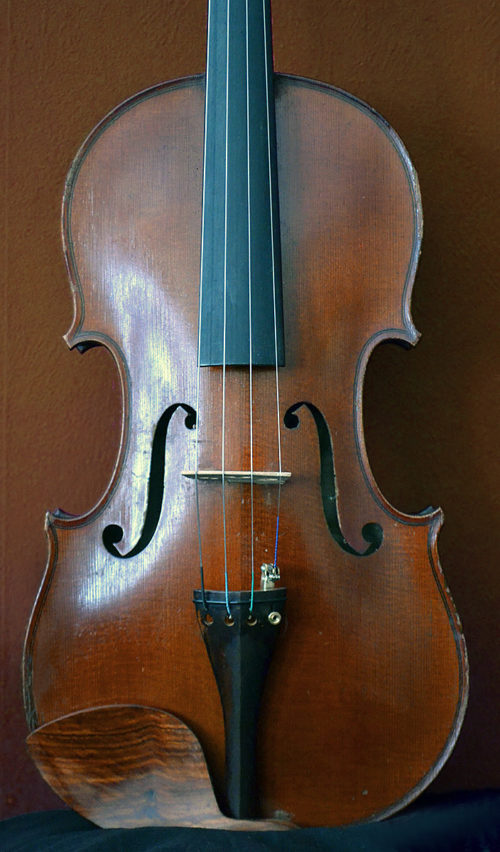 Full size, Charles Fetique violin (French, early 20th century – circa 1930), with original label inside. This is a rich, sonorous instrument. A deep, round tone, that – like all good violins – does not make you work overly hard to attain. It has a darker, lush, round tone that professional players love – and great projection. We recently A-B'd this instrument against $5k+ violins in the area, and there was no comparison, this instrument was louder, more full, more round and full in the bass notes, and all around a stellar performer. This violin would be a great student violin upgrade – for that aspiring violinist who is ready to graduate to, and enjoy, a better instrument than what's typically available in the $4-5K range, at a very attractive price. And, the buyer will have the confidence of both a Letter of Expertise, and a professional appraisal: • Certificate: Jean-Jacques Rampal, Paris, 2014. (This is the letter of expertise, on this violin, from one of the top experts on French Violins, in Paris, France). And: • Written, professional appraisal of the violin, done from personal inspection, from one of the top violin shops/experts in Texas (Jay R. Rury Violins, Dallas), with a valuation of $3,500.00 Both the above documents will be included with the sale. The violin is in excellent condition. There are no sound post, or bass bar cracks. It was professionally set up to play, by Blackerby Violin in Austin. In a modern Tonerelli case. Price: $3250.
Full size, Charles Fetique violin (French, early 20th century – circa 1930), with original label inside. This is a rich, sonorous instrument. A deep, round tone, that – like all good violins – does not make you work overly hard to attain. It has a darker, lush, round tone that professional players love – and great projection. We recently A-B'd this instrument against $5k+ violins in the area, and there was no comparison, this instrument was louder, more full, more round and full in the bass notes, and all around a stellar performer. This violin would be a great student violin upgrade – for that aspiring violinist who is ready to graduate to, and enjoy, a better instrument than what's typically available in the $4-5K range, at a very attractive price. And, the buyer will have the confidence of both a Letter of Expertise, and a professional appraisal: • Certificate: Jean-Jacques Rampal, Paris, 2014. (This is the letter of expertise, on this violin, from one of the top experts on French Violins, in Paris, France). And: • Written, professional appraisal of the violin, done from personal inspection, from one of the top violin shops/experts in Texas (Jay R. Rury Violins, Dallas), with a valuation of $3,500.00 Both the above documents will be included with the sale. The violin is in excellent condition. There are no sound post, or bass bar cracks. It was professionally set up to play, by Blackerby Violin in Austin. In a modern Tonerelli case. Price: $3250. -
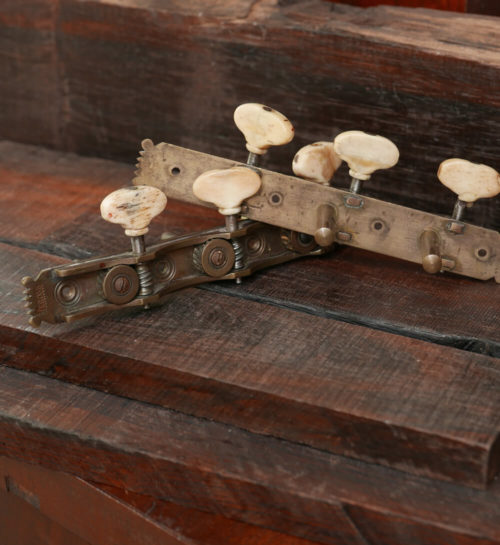 Even more rare, early Jerome’s, made in France. Circa 1840 -1850. Unusual design. Missing one post/worm gear. Damage to one worm gear bracket. Price: $795.
Even more rare, early Jerome’s, made in France. Circa 1840 -1850. Unusual design. Missing one post/worm gear. Damage to one worm gear bracket. Price: $795. -
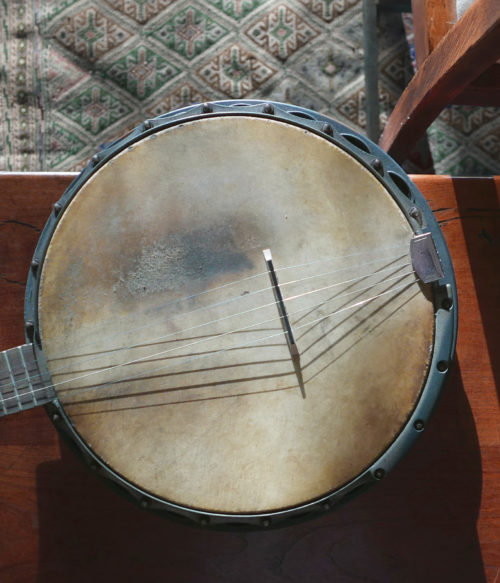 This Banjo has a unique tone, that only comes from a Gretsch Die-cast metal shell/flange construction, prewar banjo. But it’s rare to see these banjos in anything other than tenor. This one is a rare, original 5 string configuration, and has a nice “Gretsch growl” (a term that some drummers use to describe Gretsch drums). Wonderful, dark tone, with bell-like high notes. And with a bit of sustain that is reminiscent of a prewar Dobro guitar. Growl, plus sustain, and ringing highs – only from a Gretsch prewar banjo. Pearloid heastock overlay. 11 inch head. 26 inch scale length. 22-fret Brazilian rosewood fingerboard, with dot markers. Walnut neck, and resonator. Top tension head adjustment with 20 lugs. Original calf skin head. Price: $750.
This Banjo has a unique tone, that only comes from a Gretsch Die-cast metal shell/flange construction, prewar banjo. But it’s rare to see these banjos in anything other than tenor. This one is a rare, original 5 string configuration, and has a nice “Gretsch growl” (a term that some drummers use to describe Gretsch drums). Wonderful, dark tone, with bell-like high notes. And with a bit of sustain that is reminiscent of a prewar Dobro guitar. Growl, plus sustain, and ringing highs – only from a Gretsch prewar banjo. Pearloid heastock overlay. 11 inch head. 26 inch scale length. 22-fret Brazilian rosewood fingerboard, with dot markers. Walnut neck, and resonator. Top tension head adjustment with 20 lugs. Original calf skin head. Price: $750. -
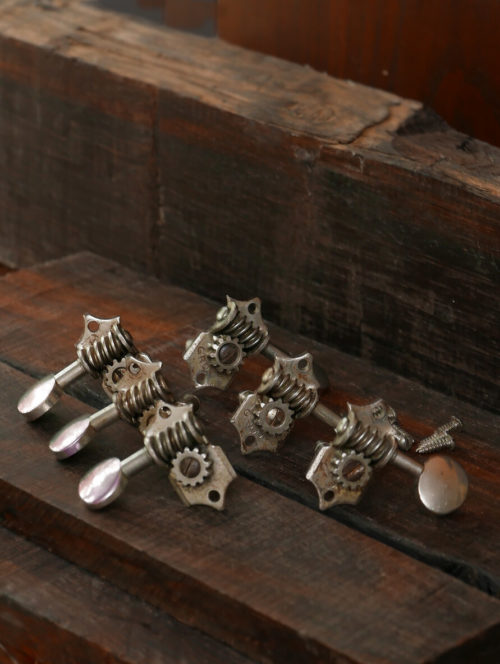 6:1 ratio pre war Grovers, mid-1930's. As used on Martin pre-war dreadoaught guitars. Oval buttons, bevelled edges on the baseplate. Just one button has some missing chrome on one side (see photos). With bushings, and mounting screws. No bent shafts. Good working condition. Price: $795.
6:1 ratio pre war Grovers, mid-1930's. As used on Martin pre-war dreadoaught guitars. Oval buttons, bevelled edges on the baseplate. Just one button has some missing chrome on one side (see photos). With bushings, and mounting screws. No bent shafts. Good working condition. Price: $795. -
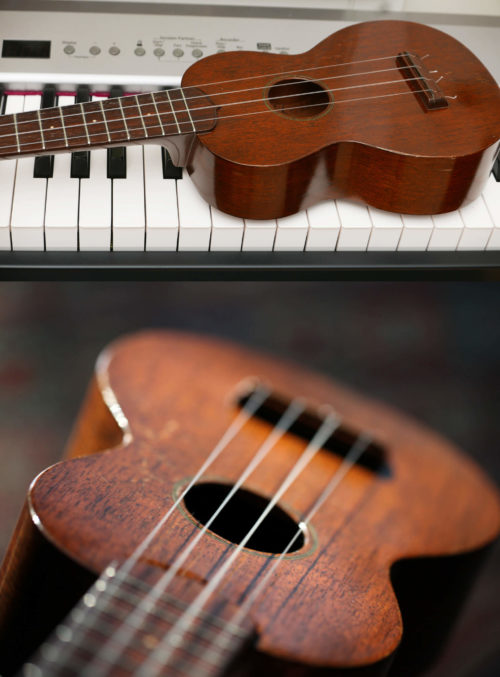 This is great example of Martin’s post war, 1950’s style 0 Ukulele. It has a few nicks and dings, but it’s 100% crack free. And it’s in its original case. It was made between 1957 and 1960 (as indicated by the tuners, and the lack of the “Made in U.S.A.”). Price: $995.
This is great example of Martin’s post war, 1950’s style 0 Ukulele. It has a few nicks and dings, but it’s 100% crack free. And it’s in its original case. It was made between 1957 and 1960 (as indicated by the tuners, and the lack of the “Made in U.S.A.”). Price: $995. -
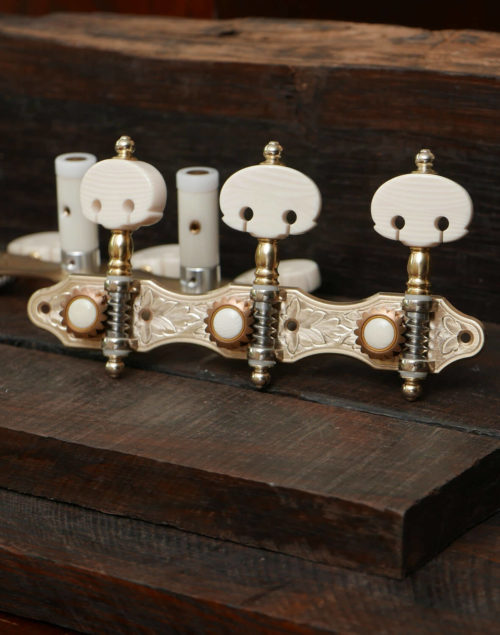 Alessi, Hauser style machine head tuners. More rare, deep silver plating. Hand made in Italy. Engraved with high detail. These are new, old stock. Made circa 2009, they have never been used or mounted on a guitar, and they come with the original mounting screws, and in their original wood presentation case. Synthetic ivory kidney shaped buttons (rare style). 35mm on center. Perfect, unused condition. Price: $895.
Alessi, Hauser style machine head tuners. More rare, deep silver plating. Hand made in Italy. Engraved with high detail. These are new, old stock. Made circa 2009, they have never been used or mounted on a guitar, and they come with the original mounting screws, and in their original wood presentation case. Synthetic ivory kidney shaped buttons (rare style). 35mm on center. Perfect, unused condition. Price: $895. -
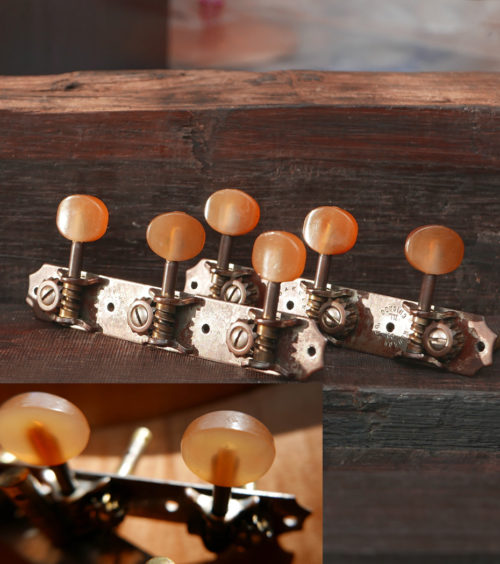 Pre-war Kluson tuners from the 1930's. Amber buttons. These are rare tuners that came on some of the nice Gibsons of the era, such as a few Gibson J35's. Good working condition. Price: $295. – on Hold
Pre-war Kluson tuners from the 1930's. Amber buttons. These are rare tuners that came on some of the nice Gibsons of the era, such as a few Gibson J35's. Good working condition. Price: $295. – on Hold -
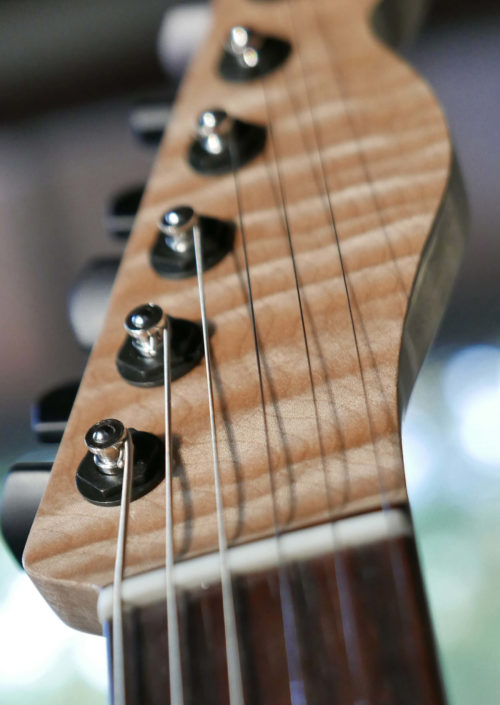 Another original, new, beautiful Custom Tele from master luthier Tony Nobles, based in Wimberly Texas. (Tony has crafted custom guitars for artists ranging in style from Joe Walsh to Alejandro Escovedo.) This guitar was custom made to our specs. And it’s one of one– the only one made with these features. Body: Figured Walnut top over adler Custom high end Musikraft quilted maple neck Width at the Nut: 1-11/16" Width at the Heel: 2-3/16 (55.56mm) Number of Frets: 21 Fret Type: Medium 6105 Finger Board Radius: 10" Body: natural, nitro lacquer finish Back of neck: natural, no finish Front of headstock: natural, nitro lacquer finish Bridge: Hannes by Schaller Non-Tremolo Bridge, #GTH RU-BLACK RUTHENIUM Tuners: Sperzel Trimlok Locking Guitar Tuners 6-in-line Trim-Lok Black Pickups: Harmonic Design "Vintage Plus" bridge and neck pickups
Another original, new, beautiful Custom Tele from master luthier Tony Nobles, based in Wimberly Texas. (Tony has crafted custom guitars for artists ranging in style from Joe Walsh to Alejandro Escovedo.) This guitar was custom made to our specs. And it’s one of one– the only one made with these features. Body: Figured Walnut top over adler Custom high end Musikraft quilted maple neck Width at the Nut: 1-11/16" Width at the Heel: 2-3/16 (55.56mm) Number of Frets: 21 Fret Type: Medium 6105 Finger Board Radius: 10" Body: natural, nitro lacquer finish Back of neck: natural, no finish Front of headstock: natural, nitro lacquer finish Bridge: Hannes by Schaller Non-Tremolo Bridge, #GTH RU-BLACK RUTHENIUM Tuners: Sperzel Trimlok Locking Guitar Tuners 6-in-line Trim-Lok Black Pickups: Harmonic Design "Vintage Plus" bridge and neck pickups -
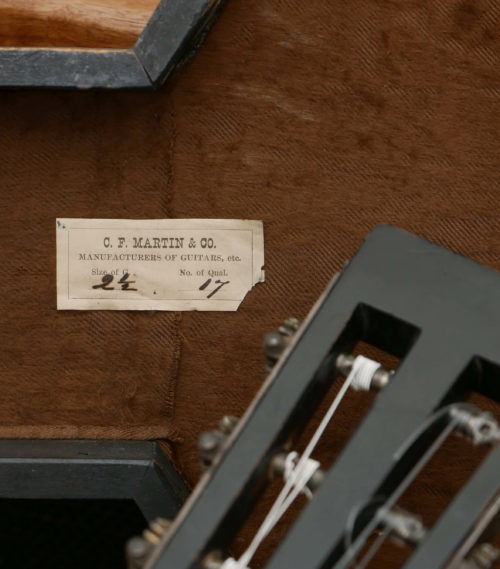 19th century Martin parlor guitar. This lovely sounding Martin 2 1/2-17 features solid Brazilian Rosewood back and sides, Adirondack spruce top, and original Jerome tuners. This particular instrument has a beautiful, lyrical voice. It was made probably circa 1867-1870. There are several clues to establish that: the original coffin case with the guitar has attributes of an earlier case: the small brass handle, and the label inside the case has font and other attributes of late a 1860s case. Also, the particular style of the original Jerome Tuners. Kerfing inside is also indicative of an 1860’s Martin. And, the best clue of all: the 1 ¾ inch nut width. Of course, it’s post-1867, because of the “CF Martin & Co” stamps inside. The top is fan braced, typical of this style. Measurements are: body length 17 7/8", lower bout width 11 5/8", overall length 36 1/2"; scale length 24 ½ inches. 4 inch body depth at end pin; 3 3/8 inch boy depth at neck joint. 1 ¾ inch nut width– may have been a custom order, or just a slightly narrower nut width (from the 1 7/8 more common later) from the factory. 12 fret cedar neck/ebonized, with ice cream cone heel. All original finish, everywhere. A fair-to-low amount of playwear (see photos). Original bar frets in fine condition. Several small hairline cracks in back, repaired. Top and sides also have a couple or repaired cracks. Reproduction ebony bridge– just made by Dick Dubois.. Original bar frets. Original bracing. "C.F. MARTIN &CO/ NEW YORK" hot stamped on back strip inside, and heel block. CF Martin New York stamped on back, by heel joint. Original Jerome tuners, with original buttons– note, one of the sun gears (on the G string tuner) has been replaced, with a different 19th century Martin sun gear (see photo). Historical interest aside (these just-post-civil war Martin guitars are more rare than the 1870’s/1880’s/1890’s examples), this guitar plays wonderfully. It projects glassy brazilian trebles, and clear mids and bass notes. It’s just a joy to play, and it just floats in your hands (due to its very light weight). Action is good, and it plays in tune even on the higher frets. (Note: 19th century Martins can be fitted with: gut strings, classical guitar strings, or sometimes silk and steel/tuned down–depending on the guitar. It’s really a case-by-case basis. One size does not fit all. And different 19th century Martins sound better with different strings. In this case, with this particular guitar, our favorite strings if you want a “classical” style string but more brightness and volume than nylon classical strings: Savarez Alliance composite High Tension strings (note, “high tension” by classical standards– fine for this instrument). This instruments sounds wonderful with those strings. In is original coffin case (and case has all the original hardware, as well as its original cloth interior lining).
19th century Martin parlor guitar. This lovely sounding Martin 2 1/2-17 features solid Brazilian Rosewood back and sides, Adirondack spruce top, and original Jerome tuners. This particular instrument has a beautiful, lyrical voice. It was made probably circa 1867-1870. There are several clues to establish that: the original coffin case with the guitar has attributes of an earlier case: the small brass handle, and the label inside the case has font and other attributes of late a 1860s case. Also, the particular style of the original Jerome Tuners. Kerfing inside is also indicative of an 1860’s Martin. And, the best clue of all: the 1 ¾ inch nut width. Of course, it’s post-1867, because of the “CF Martin & Co” stamps inside. The top is fan braced, typical of this style. Measurements are: body length 17 7/8", lower bout width 11 5/8", overall length 36 1/2"; scale length 24 ½ inches. 4 inch body depth at end pin; 3 3/8 inch boy depth at neck joint. 1 ¾ inch nut width– may have been a custom order, or just a slightly narrower nut width (from the 1 7/8 more common later) from the factory. 12 fret cedar neck/ebonized, with ice cream cone heel. All original finish, everywhere. A fair-to-low amount of playwear (see photos). Original bar frets in fine condition. Several small hairline cracks in back, repaired. Top and sides also have a couple or repaired cracks. Reproduction ebony bridge– just made by Dick Dubois.. Original bar frets. Original bracing. "C.F. MARTIN &CO/ NEW YORK" hot stamped on back strip inside, and heel block. CF Martin New York stamped on back, by heel joint. Original Jerome tuners, with original buttons– note, one of the sun gears (on the G string tuner) has been replaced, with a different 19th century Martin sun gear (see photo). Historical interest aside (these just-post-civil war Martin guitars are more rare than the 1870’s/1880’s/1890’s examples), this guitar plays wonderfully. It projects glassy brazilian trebles, and clear mids and bass notes. It’s just a joy to play, and it just floats in your hands (due to its very light weight). Action is good, and it plays in tune even on the higher frets. (Note: 19th century Martins can be fitted with: gut strings, classical guitar strings, or sometimes silk and steel/tuned down–depending on the guitar. It’s really a case-by-case basis. One size does not fit all. And different 19th century Martins sound better with different strings. In this case, with this particular guitar, our favorite strings if you want a “classical” style string but more brightness and volume than nylon classical strings: Savarez Alliance composite High Tension strings (note, “high tension” by classical standards– fine for this instrument). This instruments sounds wonderful with those strings. In is original coffin case (and case has all the original hardware, as well as its original cloth interior lining). -
Out of stock
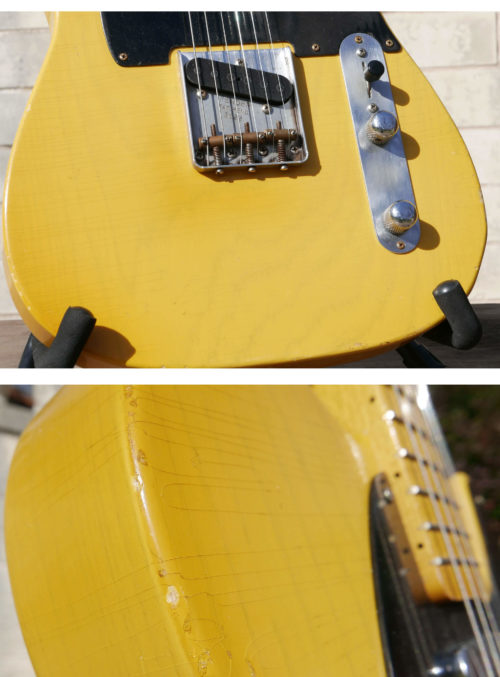 This could be the best blackguard telecaster tribute ever. An homage to the great early 50’s telecaster. But it only gets accolades if it’s a great player. This one is a great player–its light weight (same weight range as on original early 50s telecaster), pickups, setup, and attention to detail make for a great sounding tele. A joy to play. There appear to be a few original 1952/1953 parts on this guitar– but this guitar is being offered strictly as a reproduction/tribute. And it’s a tribute, in its way, to the art of the (great) copy– and on that note, it comes with Nacho Baños’ great book, The Blackguard book (out of print and a $300-400 value in itself), with matching serial number on the cover of the book. (Click here for a story on Baños.) So the purchaser can follow along the narrative of some of the great original early Blackguards in the book–and how to identify original early 50’s Telecaster, Nocaster, and Esquire elements and parts– while having fun with this intriguing tribute guitar. • The bridge, a good reproduction of unknown origin. The photos tell the story. (Original early 50’s brass saddles?). Reproduction tuners. • The pickguard looks convincing, but we're calling it a reproduction. • Seymour Duncan Antiquity pickups. • The pots, and the pickup switch, appear to be original 1952 or 1953 Fender parts (but not with original solder joints etc). • The control plate appears to be an original 1952/1953 Fender plate. Tone, volume knobs are (good) reproductions. • Neck is from Mark Jenny, stamped on heel as official Fender “Licensed” neck. Medium C profile. Great feel– not baseball bat, and not too thin. • Weight, with strings: 6.625 lbs. This is in the same weight range as original early 50s telecasters. Compare to the weight of mediocre telecaster “reissues” on the market today, all of which weigh much more. • The body is by Mark Jenny. We waited patiently for over a year until the right Jenny body became available, to complete this instrument in the best way possible and to remove from the market the (nice light weight) reproduction body that was in place when we acquired the guitar that had a non-authentic 1952 date and signature in the neck pocket. The right thing to do– and the Mark Jenny body in place now has crazing and other elements characteristic to the early blackguard look, weight, wear, and feel. • Set up perfectly, and ready to play. Sold as a reproduction/tribute guitar only, together with the Nacho Baños The Blackguard book (book in as-new condition in original box) that will school the new owner on how to evaluate the fine, fully pedigreed, great Blackguards of the early 50’s. Price: $5950.
This could be the best blackguard telecaster tribute ever. An homage to the great early 50’s telecaster. But it only gets accolades if it’s a great player. This one is a great player–its light weight (same weight range as on original early 50s telecaster), pickups, setup, and attention to detail make for a great sounding tele. A joy to play. There appear to be a few original 1952/1953 parts on this guitar– but this guitar is being offered strictly as a reproduction/tribute. And it’s a tribute, in its way, to the art of the (great) copy– and on that note, it comes with Nacho Baños’ great book, The Blackguard book (out of print and a $300-400 value in itself), with matching serial number on the cover of the book. (Click here for a story on Baños.) So the purchaser can follow along the narrative of some of the great original early Blackguards in the book–and how to identify original early 50’s Telecaster, Nocaster, and Esquire elements and parts– while having fun with this intriguing tribute guitar. • The bridge, a good reproduction of unknown origin. The photos tell the story. (Original early 50’s brass saddles?). Reproduction tuners. • The pickguard looks convincing, but we're calling it a reproduction. • Seymour Duncan Antiquity pickups. • The pots, and the pickup switch, appear to be original 1952 or 1953 Fender parts (but not with original solder joints etc). • The control plate appears to be an original 1952/1953 Fender plate. Tone, volume knobs are (good) reproductions. • Neck is from Mark Jenny, stamped on heel as official Fender “Licensed” neck. Medium C profile. Great feel– not baseball bat, and not too thin. • Weight, with strings: 6.625 lbs. This is in the same weight range as original early 50s telecasters. Compare to the weight of mediocre telecaster “reissues” on the market today, all of which weigh much more. • The body is by Mark Jenny. We waited patiently for over a year until the right Jenny body became available, to complete this instrument in the best way possible and to remove from the market the (nice light weight) reproduction body that was in place when we acquired the guitar that had a non-authentic 1952 date and signature in the neck pocket. The right thing to do– and the Mark Jenny body in place now has crazing and other elements characteristic to the early blackguard look, weight, wear, and feel. • Set up perfectly, and ready to play. Sold as a reproduction/tribute guitar only, together with the Nacho Baños The Blackguard book (book in as-new condition in original box) that will school the new owner on how to evaluate the fine, fully pedigreed, great Blackguards of the early 50’s. Price: $5950. -
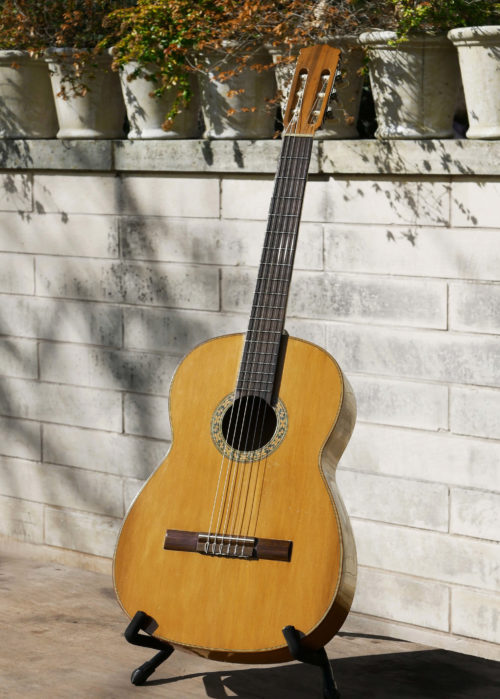 Another instrument from Enos Hernandez of Mexico, one of the best luthiers to ever live in work in Mexico, circa 1970’s. This one is a flamenco Blanca, with the classic cypress back and sides. Like the other Enos Hernandez we have, this one also has a cedar top. The instrument is super light weight, as a Flamenco Blanca should be, and it’s bright and percussive and raspy as a good Blanca should be. There is a scratch (not a crack) on back of guitar (see photo). There are dot position markers – original to the guitar, i.e. not added later – on top edge of fretboard (frets 3,5,7,9 – see photo). Scale length: 660mm Available January 2018 Price: $2950
Another instrument from Enos Hernandez of Mexico, one of the best luthiers to ever live in work in Mexico, circa 1970’s. This one is a flamenco Blanca, with the classic cypress back and sides. Like the other Enos Hernandez we have, this one also has a cedar top. The instrument is super light weight, as a Flamenco Blanca should be, and it’s bright and percussive and raspy as a good Blanca should be. There is a scratch (not a crack) on back of guitar (see photo). There are dot position markers – original to the guitar, i.e. not added later – on top edge of fretboard (frets 3,5,7,9 – see photo). Scale length: 660mm Available January 2018 Price: $2950 -
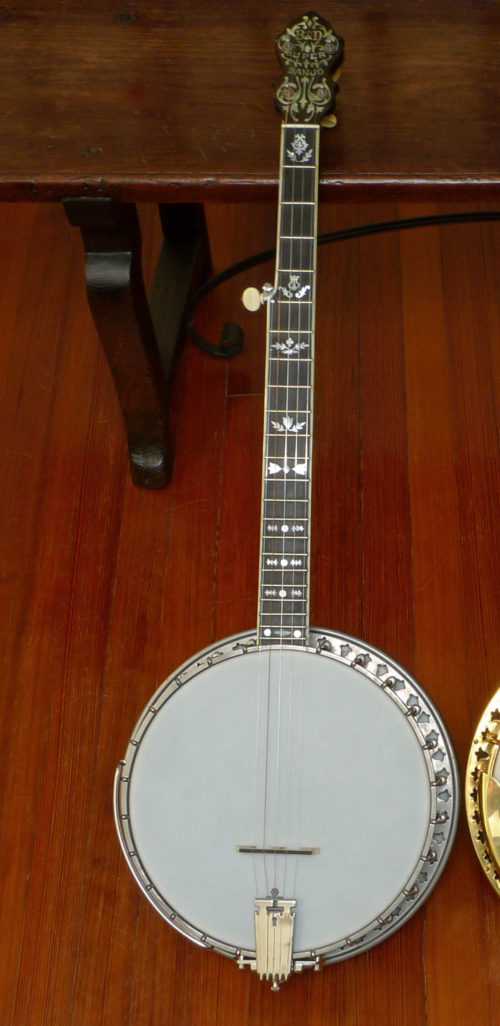 This is a superb sounding 5 string banjo. Original nickel plating. • Bacon & Day Super, 5-string Banjo (Style A) Serial number: 25892 (early 1928) • Resonator, stamped on inside (in nickel-laminated maple): Bacon Banjo Co., Inc. Groton, CT. U.S.A. Dec. 20th, 1927 • Conversion, 5 string neck (original neck was probably a tenor or plectrum); Presumably, this neck is newer than the banjo– yet the advanced MOP fret markers are as found on the earliest versions of B&D Super banjos. We assume this neck was built by one of the best U.S. “conversion” builders – with a re-use of the original MOP inlay at the peghead plus the dowel stick. Maple neck, with steel reinforcing rod. Fretboard is beautiful jet-black ebony; multi-layer neck bindings. Fretboard is a very comfortable 1 3/8 inches wide at the nut, 1 7/8 wide where fretboard meets body. • Nickel plated • 22 frets • Scale length: 27 inches • Extended Maple resonator– nickel laminated on inside • Original flat Tulip-hole flange (not the “add-on” round-hole resonator of earlier years). • Original, top of the line Type III Silver Bell tone ring (No Hole tone ring) original to the instrument (this is the most sought-after, advanced Silver Bell tone ring, introduced early 1927). • Original 2 band Grover geared tuning pegs • Fults tailpiece, and included a variety of Fults tone pins. Bob Fults made the best tailpieces available. And his tone pins let you tweak the tone of your banjo. There are several interchangeable Fults pins included here– ivory, ebony, lead, sterling silver, brass, and copper. Plus a “tone lock”. (Bob Fults recently retired, and these highly sought after Fults tailpieces and pins are no longer available.) In its original hard shell Lifton case. $3750.
This is a superb sounding 5 string banjo. Original nickel plating. • Bacon & Day Super, 5-string Banjo (Style A) Serial number: 25892 (early 1928) • Resonator, stamped on inside (in nickel-laminated maple): Bacon Banjo Co., Inc. Groton, CT. U.S.A. Dec. 20th, 1927 • Conversion, 5 string neck (original neck was probably a tenor or plectrum); Presumably, this neck is newer than the banjo– yet the advanced MOP fret markers are as found on the earliest versions of B&D Super banjos. We assume this neck was built by one of the best U.S. “conversion” builders – with a re-use of the original MOP inlay at the peghead plus the dowel stick. Maple neck, with steel reinforcing rod. Fretboard is beautiful jet-black ebony; multi-layer neck bindings. Fretboard is a very comfortable 1 3/8 inches wide at the nut, 1 7/8 wide where fretboard meets body. • Nickel plated • 22 frets • Scale length: 27 inches • Extended Maple resonator– nickel laminated on inside • Original flat Tulip-hole flange (not the “add-on” round-hole resonator of earlier years). • Original, top of the line Type III Silver Bell tone ring (No Hole tone ring) original to the instrument (this is the most sought-after, advanced Silver Bell tone ring, introduced early 1927). • Original 2 band Grover geared tuning pegs • Fults tailpiece, and included a variety of Fults tone pins. Bob Fults made the best tailpieces available. And his tone pins let you tweak the tone of your banjo. There are several interchangeable Fults pins included here– ivory, ebony, lead, sterling silver, brass, and copper. Plus a “tone lock”. (Bob Fults recently retired, and these highly sought after Fults tailpieces and pins are no longer available.) In its original hard shell Lifton case. $3750. -
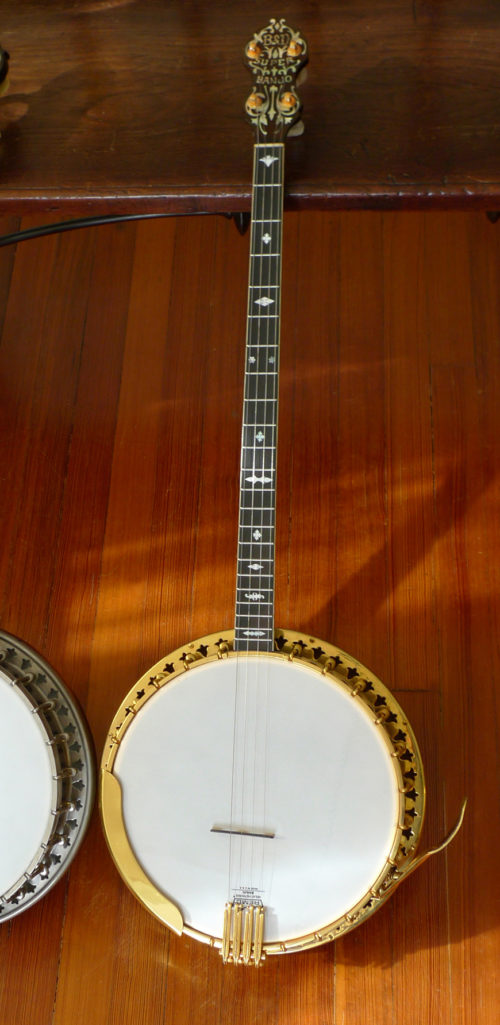 This rare 1926 example of Bacon & Day’s Super, Plectrum banjo is in wonderful condition– collectors quality, but it plays wonderfully. And this is the rare “Super” model A, gold plated. (All original, and with matching serial number on rim and dowel stick.) Original soft pedal stamped "Pat. Pend. B.&D. Soft Pedal." The original gold plating is in great condition, showing extremely little tarnishing, and no thin spots. In fact the banjo shows very little playwear at all. Original plectrum neck, original armrest– in fact all parts are original. Produced in the golden age of Bacon & Day (B&D) production, this banjo was made in Groton, CT. Although the earliest Bacon banjos were produced by various makers for Bacon from 1906-1920, the company’s best era began in 1922 when David Day left the Vega company to partner with Fred Bacon who had begun crafting his instruments in-house in 1920. The B&D banjos produced in this era are of considerably higher quality and are the sought after models by both players and collectors. The photos tell the story. 26 inch scale length. 22 fret plectrum 11″ rim In a recent hard shell case. ... no longer available ...
This rare 1926 example of Bacon & Day’s Super, Plectrum banjo is in wonderful condition– collectors quality, but it plays wonderfully. And this is the rare “Super” model A, gold plated. (All original, and with matching serial number on rim and dowel stick.) Original soft pedal stamped "Pat. Pend. B.&D. Soft Pedal." The original gold plating is in great condition, showing extremely little tarnishing, and no thin spots. In fact the banjo shows very little playwear at all. Original plectrum neck, original armrest– in fact all parts are original. Produced in the golden age of Bacon & Day (B&D) production, this banjo was made in Groton, CT. Although the earliest Bacon banjos were produced by various makers for Bacon from 1906-1920, the company’s best era began in 1922 when David Day left the Vega company to partner with Fred Bacon who had begun crafting his instruments in-house in 1920. The B&D banjos produced in this era are of considerably higher quality and are the sought after models by both players and collectors. The photos tell the story. 26 inch scale length. 22 fret plectrum 11″ rim In a recent hard shell case. ... no longer available ... -
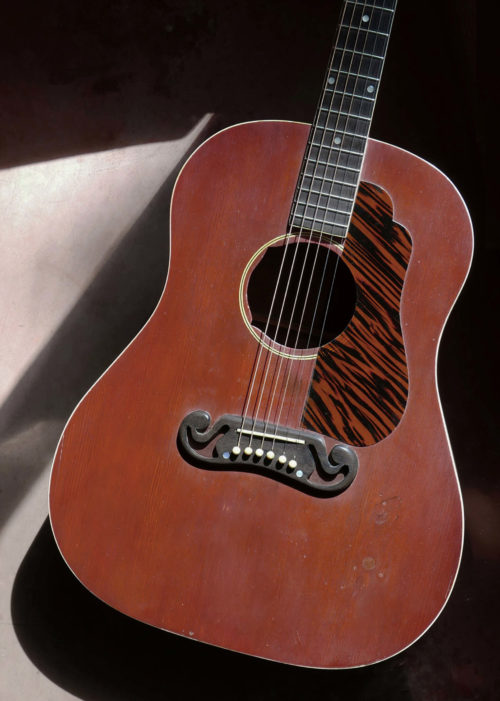 This is not your father’s J-55. And it’s not a $20K guitar. It is a wonderful player. This is an original 1939 Gibson Jumbo 55, also called the “J-55”, serial # EA5652. It is the rare, stair step headstock model, only made for a brief window in the late 30’s. It delivers the trademark, large body, prewar, long scale Gibson tone, like no other. It plays beautifully, with original bridge, frets, braces. This guitar has of course the original, Mustache bridge, and more rare– the stair step headstock. Original bridge plate. Original binding including on fretboard. Original pearl logo on the headstock (with original finish). The pickguard is a nitro cellulose reproduction meticulously crafted in our shop. It has the long scale, 25 ½ inches, that makes this model so great. And a little-known original feature of this rare model is that it has a 1 11/16 nut width, that combined with the low action makes it effortless to play, and with tone that cannot be equaled in any postwar Gibson. The intonation is spot-on, and the intonation and fretting/action are great even at the high fret positions. It was refinished in a deep Gibsonesque red, decades ago– and that makes this guitar the most affordable true 1939, stairstep headstock J-55 you will ever find. (Top thickness is fine, there was no thinning in the past). The tone is superb. And the action is superb– low and fast without sacrificing tone or volume at all.
This is not your father’s J-55. And it’s not a $20K guitar. It is a wonderful player. This is an original 1939 Gibson Jumbo 55, also called the “J-55”, serial # EA5652. It is the rare, stair step headstock model, only made for a brief window in the late 30’s. It delivers the trademark, large body, prewar, long scale Gibson tone, like no other. It plays beautifully, with original bridge, frets, braces. This guitar has of course the original, Mustache bridge, and more rare– the stair step headstock. Original bridge plate. Original binding including on fretboard. Original pearl logo on the headstock (with original finish). The pickguard is a nitro cellulose reproduction meticulously crafted in our shop. It has the long scale, 25 ½ inches, that makes this model so great. And a little-known original feature of this rare model is that it has a 1 11/16 nut width, that combined with the low action makes it effortless to play, and with tone that cannot be equaled in any postwar Gibson. The intonation is spot-on, and the intonation and fretting/action are great even at the high fret positions. It was refinished in a deep Gibsonesque red, decades ago– and that makes this guitar the most affordable true 1939, stairstep headstock J-55 you will ever find. (Top thickness is fine, there was no thinning in the past). The tone is superb. And the action is superb– low and fast without sacrificing tone or volume at all. -
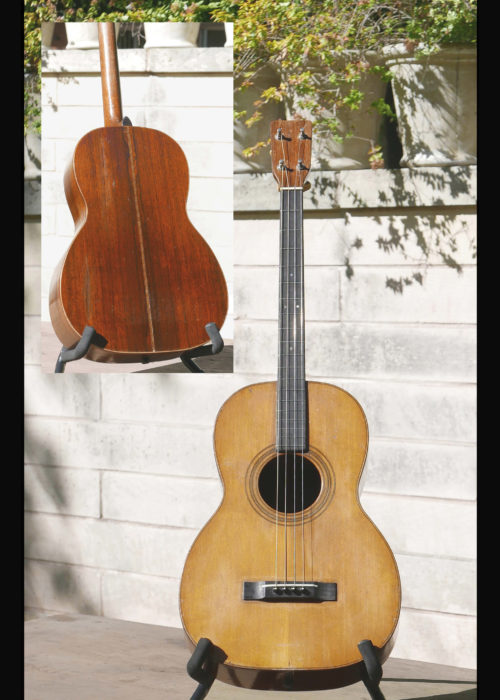 The 5-21 Martins, with their Brazilian Rosewood back and sides and Adirondack spruce tops, are known for putting out an astounding amount of sound. This tenor guitar, style 5-21T, does that in spades. Measuring 11-3/8" across, with its X braced top and light build, the instrument has an amazing amount of tone. Though Martin offered size 5 models ranging from style 15 through the elaborately ornamented style 45, the only ones made in any significant quantity prior to World War II were the style 17, 18, and 21 in six-string guitars and styles 17, 18, and 21 tenors, as well as some style 15 post-war size 5 tenors. Features of this instrument:
The 5-21 Martins, with their Brazilian Rosewood back and sides and Adirondack spruce tops, are known for putting out an astounding amount of sound. This tenor guitar, style 5-21T, does that in spades. Measuring 11-3/8" across, with its X braced top and light build, the instrument has an amazing amount of tone. Though Martin offered size 5 models ranging from style 15 through the elaborately ornamented style 45, the only ones made in any significant quantity prior to World War II were the style 17, 18, and 21 in six-string guitars and styles 17, 18, and 21 tenors, as well as some style 15 post-war size 5 tenors. Features of this instrument:- Recent neck set, and leveling of original bar frets, action is very good
- Original Grover tuning machines, working well
- Nut width of 1 1/4"
- Scale length: 22.5"
- 1 3/8" string spacing at the saddle
- Had an added tailpiece at once point (3 tiny screw holes near end pin
- No top cracks
- One repaired 11" crack on the bottom lower bout side
- One 6" repaired crack on the upper bout back under the herring bone center inlay,
- One 4” repaired crack on the lower bout back towards the bottom
- A small hole at the center of the rear headstock– probably at some point for a nail to hang the instrument on a wall
- Neck has a comfortable V shape, leaning toward a U profile
-
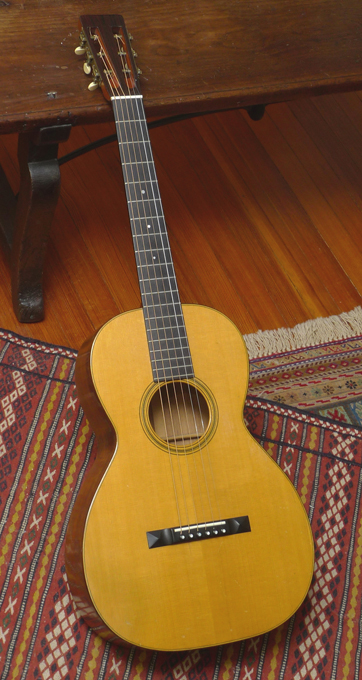 The grandson of Martin Guitar founder C. F. Martin, Sr., Frank Henry Martin suddenly found himself in control of the family business at the age of 22 when his father died in 1888 and left him unexpectedly in charge. The guitar market was still immature, and the young country was headed into an economic panic in the 1890's, but the young Frank Henry Martin quickly turned a traditional German business close to bankruptcy into a major force in the world of American music. Along with the young Frank Martin’s now legendary work ethic and marketing acumen, he is credited with personally revamping the Martin model line-up at the turn of the new century. Eschewing the trappings of an executive, he literally worked along side the shop craftsmen, day in and day out, six days a week. And he made the Style 18 the mainstay of the Martin catalog. This instrument is a living testament to that legacy– he personally signed this instrument, in cursive, under the top, on the fourth of February, 1907: “ 10381 2/4/07 F.H.M. ” Martin was still using Brazilian Rosewood for the back and sides for their 0-18 model in this 1907, and the tone of this instrument reflects all that is great about the combination of Brazilian back and sides, and Adirondack spruce (top), with a cedar neck, on the perennially great Size 0 Martin 12-fret, in all its Brazilian rosewood permutations through two centuries. This guitar is in remarkably original condition, and is completely crack-free. Just a few minor dings and superficial scratches. The finish is 100% original, with no touch-ups of any kind. The bar frets were replaced by us with period-correct bar frets–with material obtained from T.J. Thomson. (Several frets were missing, so we decided to replace all the frets.) Original ivory saddle, and bridge pins. Bridge has never been off the guitar. At some time in the past a neck set was done, so action is great, and the neck is straight. Original ebony nut is in the case. An ivory nut is installed on the guitar to accommodate silk & steel strings–which it does wonderfully. An Adirondack/Brazilian 12-fret 0-sized Martin over a century old yet in this kind of original condition, is very rare.
The grandson of Martin Guitar founder C. F. Martin, Sr., Frank Henry Martin suddenly found himself in control of the family business at the age of 22 when his father died in 1888 and left him unexpectedly in charge. The guitar market was still immature, and the young country was headed into an economic panic in the 1890's, but the young Frank Henry Martin quickly turned a traditional German business close to bankruptcy into a major force in the world of American music. Along with the young Frank Martin’s now legendary work ethic and marketing acumen, he is credited with personally revamping the Martin model line-up at the turn of the new century. Eschewing the trappings of an executive, he literally worked along side the shop craftsmen, day in and day out, six days a week. And he made the Style 18 the mainstay of the Martin catalog. This instrument is a living testament to that legacy– he personally signed this instrument, in cursive, under the top, on the fourth of February, 1907: “ 10381 2/4/07 F.H.M. ” Martin was still using Brazilian Rosewood for the back and sides for their 0-18 model in this 1907, and the tone of this instrument reflects all that is great about the combination of Brazilian back and sides, and Adirondack spruce (top), with a cedar neck, on the perennially great Size 0 Martin 12-fret, in all its Brazilian rosewood permutations through two centuries. This guitar is in remarkably original condition, and is completely crack-free. Just a few minor dings and superficial scratches. The finish is 100% original, with no touch-ups of any kind. The bar frets were replaced by us with period-correct bar frets–with material obtained from T.J. Thomson. (Several frets were missing, so we decided to replace all the frets.) Original ivory saddle, and bridge pins. Bridge has never been off the guitar. At some time in the past a neck set was done, so action is great, and the neck is straight. Original ebony nut is in the case. An ivory nut is installed on the guitar to accommodate silk & steel strings–which it does wonderfully. An Adirondack/Brazilian 12-fret 0-sized Martin over a century old yet in this kind of original condition, is very rare. -
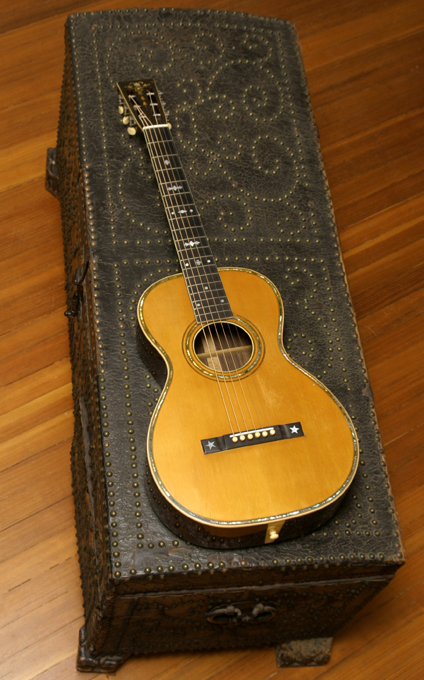 The Larson Brothers of Chicago began making steel string guitars earlier than did Martin, with their own ideas not tied to the past, and their designs are now considered by both players and collectors to be uniquely beautiful, wonderful for tone, and highly desirable. And they are much more rare guitars than Martin or Gibson– and more ornate than either Gibson or the always conservative Martin. Tone: think of a Martin Brazilian Rosewood 0-sized 12 fret from the 20’s, but add much more sustain. It vibrates in your hands, and because of Larson’s patented “built under tension” design, is thought of by players and collectors as being both unique and generating more sustain than you’ll get from any other guitar ever made. But the tone of Larsons (even the larger bodied-ones) is more treble-weighted than a Martin from the same era, so that this extra sustain does not result in a muddled sound– more like a magical shimmer and sustain that really brings out the mid- and treble-side Brazilian tone. Every part of this guitar is original. Guitar is crack-free. The bridge, never having been off the guitar, was at some point decades ago shaved slightly on top to lower the action. We have decided to keep this original bridge in place and not install a repro bridge–action is good, and the neck is straight. This particular model, is one of the very high end Larson models, with its Abalone trim, elaborate inlays on headstock and fretboard, and exquisite book-matched Brazilian rosewood back.
The Larson Brothers of Chicago began making steel string guitars earlier than did Martin, with their own ideas not tied to the past, and their designs are now considered by both players and collectors to be uniquely beautiful, wonderful for tone, and highly desirable. And they are much more rare guitars than Martin or Gibson– and more ornate than either Gibson or the always conservative Martin. Tone: think of a Martin Brazilian Rosewood 0-sized 12 fret from the 20’s, but add much more sustain. It vibrates in your hands, and because of Larson’s patented “built under tension” design, is thought of by players and collectors as being both unique and generating more sustain than you’ll get from any other guitar ever made. But the tone of Larsons (even the larger bodied-ones) is more treble-weighted than a Martin from the same era, so that this extra sustain does not result in a muddled sound– more like a magical shimmer and sustain that really brings out the mid- and treble-side Brazilian tone. Every part of this guitar is original. Guitar is crack-free. The bridge, never having been off the guitar, was at some point decades ago shaved slightly on top to lower the action. We have decided to keep this original bridge in place and not install a repro bridge–action is good, and the neck is straight. This particular model, is one of the very high end Larson models, with its Abalone trim, elaborate inlays on headstock and fretboard, and exquisite book-matched Brazilian rosewood back.- Year: 1926
- Model: 562
- Serial number: 31778
- This is the Maurer Larson Brothers “Standard size”: lower bout width: 12 3/4 inches
- Brazilian rosewood back and sides
- Spruce top
- Larson's “laminated” X braces. This is the patented Larson Brothers’ bracing, with each brace being Spruce/Rosewood/Spruce
- Larson’s patented “built under tension” design
- Trim: Abalone pearl and herringbone bordering the top and sound hole
- Torch-style pearl headstock inlay
- Radiused ebony fingerboard, and Classic Larson Brothers’ “ebony below the binding”
- Engraved inlays on fretboard
- Original Engraved Waverly tuners
- Original Ivory bridge pins
- 1-7/8" wide nut
- 2-5/16" bridge string spacing
- 24.5" scale length
- One-piece mahogany neck, round C shaped neck profile.
-
 The Larson Brothers of Chicago never marketed any guitar, throughout their long career, that was marked “Larson”. Their designs were branded by Maurer, Stahl, Prarie State, Stetson, and a few other guitar makers– but never “Larson”. They were also known for making many “off-catalog” guitars, i.e. guitars with combinations of features that varied from the Maurer, Stahl, etc, catalogs, and guitars that were not marked at all with a brand. This guitar is a Larson Bros creation that is not marked at all. It is a custom made instrument–but it has all the typical Larson hallmarks. The tone of this Larson is every bit as wonderful as the Maurer/Larson listed above, indeed it is quite similar, due to the same patented “built under tension” design, and X-bracing. This Larson does not have laminated braces (it’s well documented that laminated braces were only used on certain models–and their use was not related to level or price.) Every part of this guitar is original, including original finish. There are two repaired cracks on the back, and three small, repaired cracks on top.
The Larson Brothers of Chicago never marketed any guitar, throughout their long career, that was marked “Larson”. Their designs were branded by Maurer, Stahl, Prarie State, Stetson, and a few other guitar makers– but never “Larson”. They were also known for making many “off-catalog” guitars, i.e. guitars with combinations of features that varied from the Maurer, Stahl, etc, catalogs, and guitars that were not marked at all with a brand. This guitar is a Larson Bros creation that is not marked at all. It is a custom made instrument–but it has all the typical Larson hallmarks. The tone of this Larson is every bit as wonderful as the Maurer/Larson listed above, indeed it is quite similar, due to the same patented “built under tension” design, and X-bracing. This Larson does not have laminated braces (it’s well documented that laminated braces were only used on certain models–and their use was not related to level or price.) Every part of this guitar is original, including original finish. There are two repaired cracks on the back, and three small, repaired cracks on top.- Lower bout width: 12 5/8 inches
- Brazilian rosewood back and sides
- Ivory celluloid Bound fretboard
- Ivory celluloid Bound headstock
- Spruce top
- X braced
- Larson’s patented “built under tension” design
- Rosette: Abalone pearl and wood inlay bordering the sound hole
- Radiused ebony fingerboard, and Classic Larson Brothers’ “ebony below the binding”
- Engraved inlays on fretboard
- Original tuners
- Original ebony bridge
- Original bridge pins
- 1-7/8" wide nut
- 2 1/4" bridge string spacing
- 24.3" scale length
- One-piece mahogany neck, round C shaped neck profile.
-
 Nothing sounds like a 30’s Gibson L-00. No longer a sleeper on the vintage guitar market–they are sought after by working musicians the world over¬–they are still under-rated on the collector market. These mid-size Gibsons are incredibly resonant. There is nothing like them, from Gibson, and the mid-size Adirondack spruce over mahogany Martins from the mid to late 30’s command more than twice the price. This L-00 from 1938 has the best tone of any of the 30’s L-00’s we’ve seen. You won’t believe its presence. Acquired by us from the family of the original owner in Austin, Texas, this guitar is a great example of the era when Gibson still had a production jump on Martin, and even its lower cost guitars were winning the marketing war at the trailing end of the depression. This L-00 had a re-spray of its burst in the early 60’s, so while not the original finish, it’s got the right look and feel of the 30’s, and plenty of mileage to make it more than convincing. The top and sides are completely crack-free, and there are only two small cracks on the back. One is not through the wood, and the other was expertly addressed by Tony Nobles with a small cleat. Tony also made a new perfect reproduction Brazilian Rosewood bridge. The bridge plate is original and in great condition. Original firestripe pickguard. Original nut. The non-original tuners on the instrument when we acquired it were replaced by us with klusons from the period. Tony also installed new T-frets. While we tend to specialize in vintage Martins, this one might change my mind.
Nothing sounds like a 30’s Gibson L-00. No longer a sleeper on the vintage guitar market–they are sought after by working musicians the world over¬–they are still under-rated on the collector market. These mid-size Gibsons are incredibly resonant. There is nothing like them, from Gibson, and the mid-size Adirondack spruce over mahogany Martins from the mid to late 30’s command more than twice the price. This L-00 from 1938 has the best tone of any of the 30’s L-00’s we’ve seen. You won’t believe its presence. Acquired by us from the family of the original owner in Austin, Texas, this guitar is a great example of the era when Gibson still had a production jump on Martin, and even its lower cost guitars were winning the marketing war at the trailing end of the depression. This L-00 had a re-spray of its burst in the early 60’s, so while not the original finish, it’s got the right look and feel of the 30’s, and plenty of mileage to make it more than convincing. The top and sides are completely crack-free, and there are only two small cracks on the back. One is not through the wood, and the other was expertly addressed by Tony Nobles with a small cleat. Tony also made a new perfect reproduction Brazilian Rosewood bridge. The bridge plate is original and in great condition. Original firestripe pickguard. Original nut. The non-original tuners on the instrument when we acquired it were replaced by us with klusons from the period. Tony also installed new T-frets. While we tend to specialize in vintage Martins, this one might change my mind. -
 Another Gibson L-00, with great tone and volume, and all original finish. The top and sides are completely crack-free, and there are several small dryness cracks on the back. The bridge is original, and has never been off the guitar. We just set the neck, and installed a new bone saddle. The bridge plate is original and in perfect condition. Original firestripe pickguard. Original nut. Original frets.
Another Gibson L-00, with great tone and volume, and all original finish. The top and sides are completely crack-free, and there are several small dryness cracks on the back. The bridge is original, and has never been off the guitar. We just set the neck, and installed a new bone saddle. The bridge plate is original and in perfect condition. Original firestripe pickguard. Original nut. Original frets. -
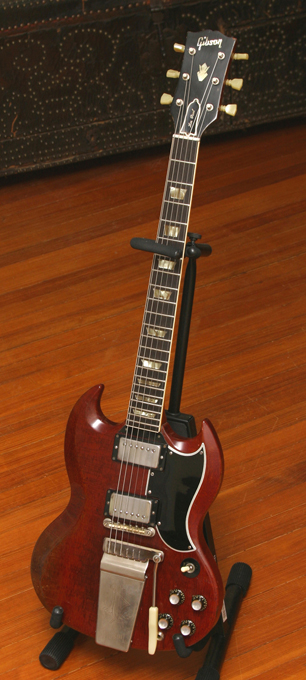 1963 and 1964 were the best years for the legendary early 60's Gibson SG. And 63-64 saw the transition from the Les Paul model to the "Solid Guitar" or SG. Only in 63 and 64 did Gibson use a particularly wide neck on the SG, and that's why players love SG's from these two seminal years. This '64 SG is something of a transition model from the last of the double cutaway Les Paul/SG's to the SG Standard-it carries the Les Paul truss rod cover (original to the guitar), and it features the great lyre vibrola (nickel). This 1964 SG, with all original finish, and original parts (including Patent # humbuckers), is a wonderful instrument with the right amount of honest wear to make it fit like a glove, and play like a dream in your left hand with that wonderful ample neck.
1963 and 1964 were the best years for the legendary early 60's Gibson SG. And 63-64 saw the transition from the Les Paul model to the "Solid Guitar" or SG. Only in 63 and 64 did Gibson use a particularly wide neck on the SG, and that's why players love SG's from these two seminal years. This '64 SG is something of a transition model from the last of the double cutaway Les Paul/SG's to the SG Standard-it carries the Les Paul truss rod cover (original to the guitar), and it features the great lyre vibrola (nickel). This 1964 SG, with all original finish, and original parts (including Patent # humbuckers), is a wonderful instrument with the right amount of honest wear to make it fit like a glove, and play like a dream in your left hand with that wonderful ample neck.